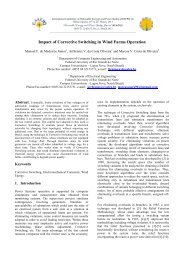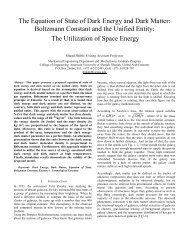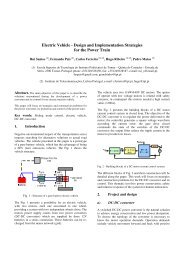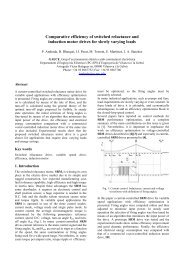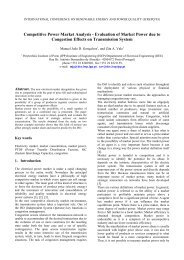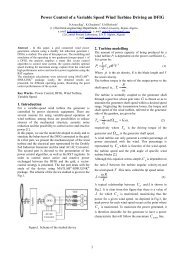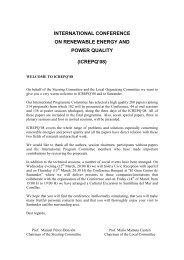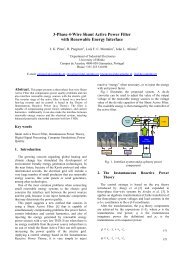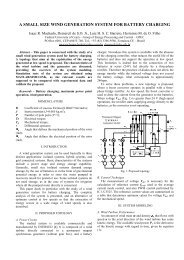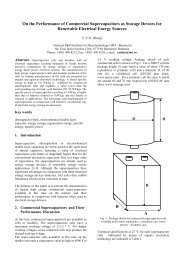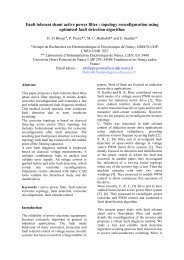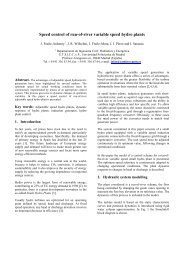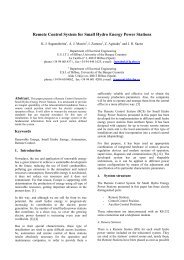The Effect of Solar Irradiance on the Power Quality ... - Icrepq.com
The Effect of Solar Irradiance on the Power Quality ... - Icrepq.com
The Effect of Solar Irradiance on the Power Quality ... - Icrepq.com
Create successful ePaper yourself
Turn your PDF publications into a flip-book with our unique Google optimized e-Paper software.
<str<strong>on</strong>g>The</str<strong>on</strong>g> <str<strong>on</strong>g>Effect</str<strong>on</strong>g> <str<strong>on</strong>g>of</str<strong>on</strong>g> <str<strong>on</strong>g>Solar</str<strong>on</strong>g> <str<strong>on</strong>g>Irradiance</str<strong>on</strong>g> <strong>on</strong> <strong>the</strong> <strong>Power</strong> <strong>Quality</strong> Behaviour <str<strong>on</strong>g>of</str<strong>on</strong>g> Grid<br />
C<strong>on</strong>nected Photovoltaic Systems<br />
*Minas Patsalides 1 , Demetres Evagorou 1 , George Makrides 1 ,<br />
Zen<strong>on</strong> Achillides 1 , George E. Georghiou 1,<br />
Andreas Stavrou 2 , Venizelos Efthimiou 2 ,<br />
Bastian Zinsser 3 , Wolfgang Schmitt 3 and Jürgen H. Werner 3<br />
1 Department <str<strong>on</strong>g>of</str<strong>on</strong>g> Electrical and Computer Engineering, University <str<strong>on</strong>g>of</str<strong>on</strong>g> Cyprus<br />
75 Kallipoleos Avenue, P.O. Box 20537 Nicosia, 1678, Cyprus<br />
Ph<strong>on</strong>e: + 357 22892272, Fax: + 357 22892260<br />
e-mail: ee03pm1@ucy.ac.cy, eep5de01@ucy.ac.cy, eep5mg1@ucy.ac.cy, z.achillides@cytanet.<strong>com</strong>.cy,<br />
geg@ucy.ac.cy<br />
2 Electricity Authority <str<strong>on</strong>g>of</str<strong>on</strong>g> Cyprus<br />
Amfipoleos 11, 2025, Nicosia, Cyprus<br />
Ph<strong>on</strong>e: + 357 24204058<br />
e-mail : astavrou@eac.<strong>com</strong>.cy, vefthimi@eac.<strong>com</strong>.cy<br />
3 Institut für Physikalische Elektr<strong>on</strong>ik<br />
Pfaffenwaldring 47, D-70569 Stuttgart, Germany<br />
e-mail: bastian.zinsser@ipe.uni-stuttgart.de, wolfgang.schmitt@ipe.uni-stuttgart.de,<br />
Juergen.Werner@ipe.uni-stuttgart.de<br />
Abstract. Photovoltaic systems have been increasingly used in<br />
<strong>the</strong> generati<strong>on</strong> <str<strong>on</strong>g>of</str<strong>on</strong>g> electrical energy, ei<strong>the</strong>r as a means <str<strong>on</strong>g>of</str<strong>on</strong>g> providing<br />
electricity in areas where <strong>the</strong>re is no grid c<strong>on</strong>necti<strong>on</strong> (stand al<strong>on</strong>e<br />
systems), or by providing electricity to <strong>the</strong> grid (grid c<strong>on</strong>nected<br />
systems). In a deregulated energy market, <strong>the</strong> cost <str<strong>on</strong>g>of</str<strong>on</strong>g> energy<br />
produced from fossil fuels is rising and <strong>the</strong> photovoltaic energy<br />
be<strong>com</strong>es a promising alternative source. Yet it still suffers from<br />
problems that need to be resolved in order to be widely accepted<br />
as an equivalent alternative to fossil fuels. Firstly <strong>the</strong> more direct<br />
problem <str<strong>on</strong>g>of</str<strong>on</strong>g> efficiency and cost needs to be over<strong>com</strong>e and sec<strong>on</strong>dly<br />
<strong>the</strong> indirect problem <str<strong>on</strong>g>of</str<strong>on</strong>g> <strong>the</strong> quality <str<strong>on</strong>g>of</str<strong>on</strong>g> power provided by<br />
photovoltaic technology has to be addressed. In this work 14<br />
different grid c<strong>on</strong>nected PV systems have been c<strong>on</strong>sidered and<br />
power quality measurements have been taken. Results for low and<br />
average irradiance cases are presented and analyzed in order to<br />
determine how power quality quantities are affected by changes in<br />
solar irradiance.<br />
Keywords<br />
<strong>Power</strong> quality, photovoltaic systems, solar irradiance,<br />
fluctuati<strong>on</strong>s and harm<strong>on</strong>ics<br />
1. Introducti<strong>on</strong><br />
Photovoltaic technology provides an attractive method <str<strong>on</strong>g>of</str<strong>on</strong>g><br />
power generati<strong>on</strong> and meets <strong>the</strong> criteria <str<strong>on</strong>g>of</str<strong>on</strong>g> clean energy and<br />
sustainability [1]-[4]. Advanced research is still in progress<br />
to increase <strong>the</strong> efficiency <str<strong>on</strong>g>of</str<strong>on</strong>g> photovoltaic cells and optimize<br />
<strong>the</strong> producti<strong>on</strong> <str<strong>on</strong>g>of</str<strong>on</strong>g> energy through minimizati<strong>on</strong> <str<strong>on</strong>g>of</str<strong>on</strong>g> power<br />
losses and better utilizati<strong>on</strong> <str<strong>on</strong>g>of</str<strong>on</strong>g> incident solar irradiance [5].<br />
<str<strong>on</strong>g>The</str<strong>on</strong>g> efficiency and proper operati<strong>on</strong> <str<strong>on</strong>g>of</str<strong>on</strong>g> photovoltaic<br />
systems depends <strong>on</strong> a number <str<strong>on</strong>g>of</str<strong>on</strong>g> factors. Envir<strong>on</strong>mental<br />
c<strong>on</strong>diti<strong>on</strong>s as well as system design c<strong>on</strong>stitute <strong>the</strong> most<br />
important factors in <strong>the</strong> operati<strong>on</strong> <str<strong>on</strong>g>of</str<strong>on</strong>g> <strong>the</strong> PV systems and<br />
<strong>the</strong>se can have a significant impact <strong>on</strong> <strong>the</strong> efficiency and<br />
power quality resp<strong>on</strong>se <str<strong>on</strong>g>of</str<strong>on</strong>g> <strong>the</strong> whole system [6]-[8]. <str<strong>on</strong>g>The</str<strong>on</strong>g><br />
variable power flow due to <strong>the</strong> fluctuati<strong>on</strong> <str<strong>on</strong>g>of</str<strong>on</strong>g> solar<br />
irradiance, temperature and choice <str<strong>on</strong>g>of</str<strong>on</strong>g> power semic<strong>on</strong>ductor<br />
devices are some <str<strong>on</strong>g>of</str<strong>on</strong>g> <strong>the</strong> parameters that affect <strong>the</strong> power<br />
quality <str<strong>on</strong>g>of</str<strong>on</strong>g> photovoltaic systems. Good power quality<br />
translates into obtaining a sinusoidal voltage and current<br />
output from a photovoltaic system in order to avoid<br />
harm<strong>on</strong>ics, interharm<strong>on</strong>ics and eventually voltage<br />
distorti<strong>on</strong>.<br />
With high c<strong>on</strong>necti<strong>on</strong> densities <str<strong>on</strong>g>of</str<strong>on</strong>g> photovoltaics in <strong>the</strong><br />
distributi<strong>on</strong> grid, low irradiance can lead to undesirable<br />
variati<strong>on</strong>s <str<strong>on</strong>g>of</str<strong>on</strong>g> power and supply quality (voltage and current)<br />
at <strong>the</strong> c<strong>on</strong>necti<strong>on</strong> point which might even exceed acceptable<br />
limits that are set out by <strong>the</strong> respective grid codes. Aspects<br />
related to <strong>the</strong> quality <str<strong>on</strong>g>of</str<strong>on</strong>g> electricity as generated from <strong>the</strong><br />
inverter, which is <strong>the</strong> element in a PV system resp<strong>on</strong>sible<br />
for c<strong>on</strong>verting <strong>the</strong> dc power to ac, are also important. <str<strong>on</strong>g>The</str<strong>on</strong>g><br />
circuit topology <str<strong>on</strong>g>of</str<strong>on</strong>g> <strong>the</strong> inverter can determine <strong>the</strong> behaviour<br />
and <strong>the</strong> power characteristics, during input and output<br />
changes. In additi<strong>on</strong>, large quantities <str<strong>on</strong>g>of</str<strong>on</strong>g> photovoltaic<br />
inverters can give rise to power quality problems <strong>on</strong> lowvoltage<br />
networks, even when inverters <strong>com</strong>ply with<br />
* Corresp<strong>on</strong>ding Author
standards [9]. Such behaviour, characterized by low power<br />
quality, is <str<strong>on</strong>g>of</str<strong>on</strong>g>ten troublesome because it prevents reliable<br />
equipment operati<strong>on</strong> and causes failure <str<strong>on</strong>g>of</str<strong>on</strong>g> sensitive<br />
electr<strong>on</strong>ic devices [10], [11].<br />
In this work, <strong>the</strong> power quality behaviour <str<strong>on</strong>g>of</str<strong>on</strong>g> grid c<strong>on</strong>nected<br />
PV systems has been investigated. <str<strong>on</strong>g>The</str<strong>on</strong>g> PV site under test<br />
<strong>com</strong>prises <str<strong>on</strong>g>of</str<strong>on</strong>g> 12 fixed mounted flat-plate, <strong>on</strong>e two axis<br />
tracked flat plate and <strong>on</strong>e two-axis tracked c<strong>on</strong>centrating<br />
PV system, all <str<strong>on</strong>g>of</str<strong>on</strong>g> nominal power 1 kWp, installed at <strong>the</strong><br />
University <str<strong>on</strong>g>of</str<strong>on</strong>g> Cyprus. <str<strong>on</strong>g>The</str<strong>on</strong>g> technologies involved range<br />
from m<strong>on</strong>ocrystalline and polycrystalline silic<strong>on</strong> to<br />
amorphous thin film silic<strong>on</strong>, cadmium telluride (CdTe),<br />
Copper Indium Diselenide (CIS), HIT-cell and o<strong>the</strong>r solar<br />
cell technologies from a wide range <str<strong>on</strong>g>of</str<strong>on</strong>g> manufacturers. <str<strong>on</strong>g>The</str<strong>on</strong>g><br />
systems are equally distributed through <strong>the</strong> three phases,<br />
c<strong>on</strong>nected to <strong>the</strong> grid, providing a 14 kWp three phase<br />
arrangement.<br />
<str<strong>on</strong>g>The</str<strong>on</strong>g> purpose <str<strong>on</strong>g>of</str<strong>on</strong>g> this paper is to present and evaluate<br />
measurements based <strong>on</strong> power quality quantities obtained<br />
from <strong>the</strong> PV site. <str<strong>on</strong>g>The</str<strong>on</strong>g> power quality parameters measured<br />
are <strong>com</strong>plex, active and reactive power, current and voltage<br />
harm<strong>on</strong>ics and power factor. <str<strong>on</strong>g>The</str<strong>on</strong>g> total harm<strong>on</strong>ic distorti<strong>on</strong><br />
(THD) for <strong>the</strong> voltage and current has also been measured<br />
as well, over a period <str<strong>on</strong>g>of</str<strong>on</strong>g> two weeks. <str<strong>on</strong>g>The</str<strong>on</strong>g> analysis <str<strong>on</strong>g>of</str<strong>on</strong>g><br />
measurements revealed high current total harm<strong>on</strong>ic<br />
distorti<strong>on</strong> during low solar irradiance c<strong>on</strong>diti<strong>on</strong>s. <str<strong>on</strong>g>The</str<strong>on</strong>g><br />
power factor has also been found to sometimes exceed <strong>the</strong><br />
acceptable limits, causing high quantities <str<strong>on</strong>g>of</str<strong>on</strong>g> reactive power<br />
to be supplied to <strong>the</strong> distributi<strong>on</strong> network.<br />
2. Topology <str<strong>on</strong>g>of</str<strong>on</strong>g> system under test<br />
In this work 14 PV systems have been tested which<br />
analytically include 12 fixed mounted flat-plate, <strong>on</strong>e two<br />
axis tracked flat plate and <strong>on</strong>e two-axis tracked<br />
c<strong>on</strong>centrating PV system. <str<strong>on</strong>g>The</str<strong>on</strong>g> systems are equally<br />
distributed through <strong>the</strong> three phases, c<strong>on</strong>nected to <strong>the</strong> grid,<br />
providing a 14kWp three phase arrangement. <str<strong>on</strong>g>The</str<strong>on</strong>g><br />
<strong>com</strong>binati<strong>on</strong> <str<strong>on</strong>g>of</str<strong>on</strong>g> wea<strong>the</strong>r data like global irradiati<strong>on</strong> and<br />
ambient temperature toge<strong>the</strong>r with <strong>the</strong> operating parameters<br />
<str<strong>on</strong>g>of</str<strong>on</strong>g> <strong>the</strong> 14 systems allows a <strong>com</strong>plete picture regarding <strong>the</strong>ir<br />
yield performance, degradati<strong>on</strong> and loss mechanisms to be<br />
developed. <str<strong>on</strong>g>Solar</str<strong>on</strong>g> irradiance data from <strong>the</strong> sophisticated<br />
sensor network installed <strong>on</strong> locati<strong>on</strong> have also been<br />
obtained. <str<strong>on</strong>g>The</str<strong>on</strong>g> system c<strong>on</strong>figurati<strong>on</strong> is shown in Fig. 1.<br />
3. Standards for PV grid-c<strong>on</strong>nected systems<br />
Various factors must be c<strong>on</strong>sidered when designing and<br />
installing a photovoltaic system to a distributi<strong>on</strong> network.<br />
Guidance regarding <strong>the</strong> operati<strong>on</strong> and <strong>the</strong> equipment<br />
necessary to ensure <strong>com</strong>patible operati<strong>on</strong> <str<strong>on</strong>g>of</str<strong>on</strong>g> photovoltaic<br />
systems and distributi<strong>on</strong> networks can be found in IEEE<br />
standard 929-2000 “Re<strong>com</strong>mended practice for utility<br />
interface <str<strong>on</strong>g>of</str<strong>on</strong>g> photovoltaic systems”. This specific IEEE<br />
standard c<strong>on</strong>tains informati<strong>on</strong> and restricti<strong>on</strong>s for pers<strong>on</strong>nel<br />
safety, utility system operati<strong>on</strong>, equipment protecti<strong>on</strong> and<br />
power quality.<br />
<str<strong>on</strong>g>The</str<strong>on</strong>g> IEEE Standard 519-1992 “Re<strong>com</strong>mended Practices<br />
and Requirements for Harm<strong>on</strong>ic C<strong>on</strong>trol in Electrical<br />
<strong>Power</strong> Systems” specifies <strong>the</strong> limits <str<strong>on</strong>g>of</str<strong>on</strong>g> harm<strong>on</strong>ic voltage<br />
and current at <strong>the</strong> point <str<strong>on</strong>g>of</str<strong>on</strong>g> <strong>com</strong>m<strong>on</strong> coupling between end<br />
user and distributi<strong>on</strong> utilities. <str<strong>on</strong>g>The</str<strong>on</strong>g> approach adopted in this<br />
standard requires <strong>the</strong> participati<strong>on</strong> <str<strong>on</strong>g>of</str<strong>on</strong>g> both end users and<br />
utilities. <str<strong>on</strong>g>The</str<strong>on</strong>g> limits established by this standard are equal to<br />
5 % for <strong>the</strong> voltage and current total harm<strong>on</strong>ic distorti<strong>on</strong><br />
that <strong>the</strong> producer can provide to <strong>the</strong> customer. <str<strong>on</strong>g>The</str<strong>on</strong>g> limits<br />
for <strong>the</strong> maximum individual harm<strong>on</strong>ic <strong>com</strong>p<strong>on</strong>ents are also<br />
determined and must be 3 % for voltage lower than 69 kV.<br />
Fig. 1. PV site topology
According to <strong>the</strong> European standard EN50160 (IEC<br />
50160), ac<strong>com</strong>modated by most European Grid Codes,<br />
“Voltage characteristics <str<strong>on</strong>g>of</str<strong>on</strong>g> electricity supplied by public<br />
distributi<strong>on</strong> systems”, <strong>the</strong> limit for total harm<strong>on</strong>ic distorti<strong>on</strong><br />
should not exceed 8 %, including up to <strong>the</strong> 40 th harm<strong>on</strong>ic.<br />
<str<strong>on</strong>g>The</str<strong>on</strong>g> European standard EN 61727 (IEC 61727)<br />
“Photovoltaic (PV) systems - Characteristics <str<strong>on</strong>g>of</str<strong>on</strong>g> utility<br />
interface” has established more restrictive limits for voltage<br />
and current harm<strong>on</strong>ics. <str<strong>on</strong>g>The</str<strong>on</strong>g> limits proposed for harm<strong>on</strong>ics<br />
are 2 % for total voltage harm<strong>on</strong>ic distorti<strong>on</strong> and 5 % for<br />
total current distorti<strong>on</strong>. <str<strong>on</strong>g>The</str<strong>on</strong>g> maximum for individual<br />
voltage harm<strong>on</strong>ics is also limited and must not exceed 1 %<br />
[12]-[14].<br />
4. Results and discussi<strong>on</strong><br />
<strong>Power</strong> quality parameters have been measured at <strong>the</strong> output<br />
<str<strong>on</strong>g>of</str<strong>on</strong>g> <strong>the</strong> PV site and correlated to <strong>the</strong> solar irradiance data<br />
obtained from <strong>the</strong> same site. <str<strong>on</strong>g>The</str<strong>on</strong>g> power quality parameters<br />
recorded are <strong>the</strong> <strong>com</strong>plex power, active power, reactive<br />
power, voltage and current for each harm<strong>on</strong>ic frequency.<br />
<str<strong>on</strong>g>The</str<strong>on</strong>g> power factor and total harm<strong>on</strong>ic distorti<strong>on</strong> for voltage<br />
and current have been measured as well over a period <str<strong>on</strong>g>of</str<strong>on</strong>g><br />
two weeks. <str<strong>on</strong>g>The</str<strong>on</strong>g> solar irradiance incident <strong>on</strong> <strong>the</strong> PV<br />
modules was also measured for <strong>the</strong> test period. Two cases<br />
<str<strong>on</strong>g>of</str<strong>on</strong>g> “low” and “average” irradiance have been extracted from<br />
<strong>the</strong> two week measurement data and <strong>the</strong> results are<br />
presented below.<br />
A typical example <str<strong>on</strong>g>of</str<strong>on</strong>g> <strong>the</strong> solar irradiance measurements for<br />
an average day in December in Cyprus is shown in Fig.<br />
2(a). <str<strong>on</strong>g>The</str<strong>on</strong>g> active power produced by <strong>the</strong> system, shown in<br />
Fig. 2(b), is str<strong>on</strong>gly dependent <strong>on</strong> solar irradiance.<br />
Fluctuati<strong>on</strong>s <str<strong>on</strong>g>of</str<strong>on</strong>g> solar irradiance lead to fluctuati<strong>on</strong>s <str<strong>on</strong>g>of</str<strong>on</strong>g><br />
active power supplied to <strong>the</strong> distributi<strong>on</strong> network. <str<strong>on</strong>g>The</str<strong>on</strong>g><br />
unpredictable resp<strong>on</strong>se <str<strong>on</strong>g>of</str<strong>on</strong>g> <strong>the</strong> system, assuming high<br />
densities <str<strong>on</strong>g>of</str<strong>on</strong>g> photovoltaic systems c<strong>on</strong>nected to <strong>the</strong><br />
distributi<strong>on</strong> network, can be troublesome for <strong>the</strong> producer<br />
<str<strong>on</strong>g>of</str<strong>on</strong>g> energy that has already scheduled <strong>the</strong> load for <strong>the</strong> time <str<strong>on</strong>g>of</str<strong>on</strong>g><br />
peak demand. In <strong>the</strong> case <str<strong>on</strong>g>of</str<strong>on</strong>g> unpredictable variati<strong>on</strong>s <str<strong>on</strong>g>of</str<strong>on</strong>g><br />
power quantities in distributi<strong>on</strong> networks predicti<strong>on</strong><br />
algorithms must be utilized as described in [15]. As seen<br />
from Fig. 2(c) <strong>the</strong> results for <strong>the</strong> power factor are found to<br />
be acceptable for a large fracti<strong>on</strong> <str<strong>on</strong>g>of</str<strong>on</strong>g> <strong>the</strong> day, but it can also<br />
be observed that <strong>the</strong> power factor falls below acceptable<br />
limits during <strong>the</strong> time <str<strong>on</strong>g>of</str<strong>on</strong>g> low solar irradiance. <str<strong>on</strong>g>The</str<strong>on</strong>g> reactive<br />
power as shown in Fig. 2(d) varies significantly, during <strong>the</strong><br />
day. <str<strong>on</strong>g>The</str<strong>on</strong>g> lack <str<strong>on</strong>g>of</str<strong>on</strong>g> proper c<strong>on</strong>trol to maintain <strong>the</strong> reactive<br />
power within small range limits can cause various problems<br />
to <strong>the</strong> operati<strong>on</strong> <str<strong>on</strong>g>of</str<strong>on</strong>g> <strong>the</strong> distributi<strong>on</strong> network, which is based<br />
<strong>on</strong> <strong>the</strong> c<strong>on</strong>cept <str<strong>on</strong>g>of</str<strong>on</strong>g> unity power factor, meaning that <strong>on</strong>ly a<br />
small fracti<strong>on</strong> <str<strong>on</strong>g>of</str<strong>on</strong>g> reactive power is supplied by <strong>the</strong> central<br />
power generator. <str<strong>on</strong>g>The</str<strong>on</strong>g> reactive power c<strong>on</strong>sumed by loads<br />
c<strong>on</strong>nected to <strong>the</strong> distributi<strong>on</strong> network is mostly supplied by<br />
high voltage cables and capacitors installed <strong>on</strong> nearby buses<br />
<str<strong>on</strong>g>of</str<strong>on</strong>g> <strong>the</strong> medium voltage grid. Fast variati<strong>on</strong>s <str<strong>on</strong>g>of</str<strong>on</strong>g> reactive<br />
power supplied by photovoltaic systems, assuming very<br />
high densities <str<strong>on</strong>g>of</str<strong>on</strong>g> such systems, can cause fast capacitor<br />
switching. Due to this, voltage transients and oscillati<strong>on</strong>s<br />
can occur with unpredictable amplitude and durati<strong>on</strong>.<br />
Transients can lead to failure <str<strong>on</strong>g>of</str<strong>on</strong>g> sensitive electr<strong>on</strong>ic<br />
equipment or minimizati<strong>on</strong> <str<strong>on</strong>g>of</str<strong>on</strong>g> <strong>the</strong> life expectancy <str<strong>on</strong>g>of</str<strong>on</strong>g><br />
network elements, if <strong>the</strong> amplitude <str<strong>on</strong>g>of</str<strong>on</strong>g> a transient exceeds<br />
certain limits. Thus it is desirable to reduce <strong>the</strong> existence <str<strong>on</strong>g>of</str<strong>on</strong>g><br />
such transients. Modern intelligent inverter designs are<br />
now beginning to c<strong>on</strong>sider <strong>the</strong> issue <str<strong>on</strong>g>of</str<strong>on</strong>g> <strong>the</strong> c<strong>on</strong>trol <str<strong>on</strong>g>of</str<strong>on</strong>g> <strong>the</strong><br />
reactive power by providing better <strong>com</strong>pensati<strong>on</strong> based <strong>on</strong><br />
system parameters and <strong>the</strong> needs <str<strong>on</strong>g>of</str<strong>on</strong>g> <strong>the</strong> distributi<strong>on</strong><br />
network.<br />
<str<strong>on</strong>g>Solar</str<strong>on</strong>g> <str<strong>on</strong>g>Irradiance</str<strong>on</strong>g> ( W/ m² )<br />
Active<strong>Power</strong> ( W)<br />
<strong>Power</strong> factor<br />
Reactive<strong>Power</strong> ( Var )<br />
1000<br />
900<br />
800<br />
700<br />
600<br />
500<br />
400<br />
300<br />
200<br />
100<br />
0<br />
6:28 7:40 8:52 10:04 11:16 12:28 13:40 14:52 16:04<br />
Time ( h:mm )<br />
Fig. 2(a). <str<strong>on</strong>g>Solar</str<strong>on</strong>g> <str<strong>on</strong>g>Irradiance</str<strong>on</strong>g> observed for an average day<br />
12000<br />
10000<br />
8000<br />
6000<br />
4000<br />
2000<br />
1.2<br />
1<br />
0.8<br />
0.6<br />
0.4<br />
0.2<br />
0<br />
4000<br />
3500<br />
3000<br />
2500<br />
2000<br />
1500<br />
1000<br />
0<br />
6:28 7:40 8:52 10:04 11:16 12:28 13:40 14:52 16:04<br />
Time ( h:mm )<br />
Fig. 2(b). Active <strong>Power</strong> produced for an average day<br />
6:28 7:40 8:52 10:04 11:16 12:28 13:40 14:52 16:04<br />
500<br />
Time ( h:mm )<br />
Fig. 2(c). <strong>Power</strong> Factor measured for an average day<br />
0<br />
6:28 7:40 8:52 10:04 11:16 12:28 13:40 14:52 16:04<br />
Time ( h:mm )<br />
Fig. 2(d). Reactive <strong>Power</strong> produced for an average day
Voltage RMS 3-Phase ( V)<br />
422<br />
421<br />
420<br />
419<br />
418<br />
417<br />
416<br />
415<br />
414<br />
413<br />
412<br />
6:28 7:40 8:52 10:04 11:16 12:28 13:40 14:52 16:04<br />
Time ( h:mm )<br />
Fig. 2(e). RMS Voltage (3-Phase) measured for an average day<br />
<str<strong>on</strong>g>Solar</str<strong>on</strong>g> <str<strong>on</strong>g>Irradiance</str<strong>on</strong>g> ( W/ m² )<br />
900<br />
800<br />
700<br />
600<br />
500<br />
400<br />
300<br />
200<br />
100<br />
0<br />
6:28 7:40 8:52 10:04 11:16 12:28 13:40 14:52 16:04<br />
Time ( h:mm )<br />
Fig. 3(a). <str<strong>on</strong>g>Solar</str<strong>on</strong>g> <str<strong>on</strong>g>Irradiance</str<strong>on</strong>g> observed for a low solar irradiance day<br />
2.2<br />
12000<br />
Voltage THD( %)<br />
2<br />
1.8<br />
1.6<br />
Active<strong>Power</strong> ( W)<br />
10000<br />
8000<br />
6000<br />
4000<br />
1.4<br />
2000<br />
1.2<br />
6:28 7:40 8:52 10:04 11:16 12:28 13:40 14:52 16:04<br />
Time ( h:mm )<br />
0<br />
6:28 7:40 8:52 10:04 11:16 12:28 13:40 14:52 16:04<br />
Time ( h:mm )<br />
100<br />
90<br />
80<br />
Fig. 2(f). Voltage THD measured for an average day<br />
Fig. 3(b). Active <strong>Power</strong> produced for a low solar irradiance day<br />
1.2<br />
1<br />
Current THD( %)<br />
70<br />
60<br />
50<br />
40<br />
30<br />
<strong>Power</strong> factor<br />
0.8<br />
0.6<br />
0.4<br />
20<br />
0.2<br />
10<br />
0<br />
6:28 7:40 8:52 10:04 11:16 12:28 13:40 14:52 16:04<br />
Time ( h:mm )<br />
0<br />
6:28 7:40 8:52 10:04 11:16 12:28 13:40 14:52 16:04<br />
Time ( h:mm )<br />
Fig. 2(g). Current THD measured for an average day<br />
Fig. 2. <strong>Power</strong> <strong>Quality</strong> Measurements for a day with average solar<br />
irradiance<br />
It is very important to recognize, however, that <strong>the</strong> reactive<br />
power produced by such a PV system <str<strong>on</strong>g>of</str<strong>on</strong>g> nominal peak<br />
power 14 kWp is in <strong>the</strong> range <str<strong>on</strong>g>of</str<strong>on</strong>g> 1000-2000 Var, which is<br />
<strong>com</strong>parable to <strong>the</strong> reactive power c<strong>on</strong>sumpti<strong>on</strong> <str<strong>on</strong>g>of</str<strong>on</strong>g> a host <str<strong>on</strong>g>of</str<strong>on</strong>g><br />
domestic appliances. <str<strong>on</strong>g>The</str<strong>on</strong>g> RMS voltage (3-Phase) has small<br />
range limits as shown in Fig. 2(e), indicating low<br />
dependence <strong>on</strong> solar irradiance. Voltage and current THD<br />
are shown in Fig. 2(f) and Fig. 2(g) respectively. As can be<br />
seen <strong>the</strong> voltage THD lies in <strong>the</strong> range <str<strong>on</strong>g>of</str<strong>on</strong>g> 1.2-2.2 %,<br />
whereas <strong>the</strong> current THD increases significantly at low<br />
solar irradiance c<strong>on</strong>diti<strong>on</strong>s reaching a value <str<strong>on</strong>g>of</str<strong>on</strong>g> 80 % at<br />
some instances.<br />
<str<strong>on</strong>g>The</str<strong>on</strong>g> sec<strong>on</strong>d case examined is <strong>the</strong> low irradiance <strong>on</strong>e. <strong>Power</strong><br />
quality quantities were measured and <strong>the</strong> results are shown<br />
in Fig. 3(a) to 3(g).<br />
Fig. 3(c). <strong>Power</strong> Factor measured for a low solar irradiance day<br />
Reactive<strong>Power</strong> ( Var )<br />
4000<br />
3500<br />
3000<br />
2500<br />
2000<br />
1500<br />
1000<br />
500<br />
0<br />
6:28 7:40 8:52 10:04 11:16 12:28 13:40 14:52 16:04<br />
Time ( h:mm )<br />
Fig. 3(d). Reactive <strong>Power</strong> produced for a low solar irradiance day<br />
Voltage RMS3-Phase ( V)<br />
421<br />
419<br />
417<br />
415<br />
413<br />
411<br />
6:28 7:40 8:52 10:04 11:16 12:28 13:40 14:52 16:04<br />
Time ( h:mm )<br />
Fig. 3(e). RMS Voltage (3-Phase) measured for a low solar<br />
irradiance day
2.5<br />
2.5<br />
2.4<br />
2.3<br />
2<br />
Voltage THD ( %)<br />
2.2<br />
2.1<br />
2<br />
1.9<br />
1.8<br />
VoltageTHD( %)<br />
1.5<br />
1<br />
1.7<br />
0.5<br />
1.6<br />
1.5<br />
6:28 7:40 8:52 10:04 11:16 12:28 13:40 14:52 16:04<br />
Time ( h:mm )<br />
Fig. 3(f). Voltage THD measured for a low solar irradiance day<br />
100<br />
90<br />
70<br />
60<br />
0<br />
0.00 100.00 200.00 300.00 400.00 500.00 600.00 700.00 800.00 900.00 1000.00<br />
<str<strong>on</strong>g>Solar</str<strong>on</strong>g> <str<strong>on</strong>g>Irradiance</str<strong>on</strong>g> ( W / m² )<br />
Fig. 5(a). Voltage THD vs <str<strong>on</strong>g>Solar</str<strong>on</strong>g> <str<strong>on</strong>g>Irradiance</str<strong>on</strong>g><br />
Current THD( %)<br />
80<br />
70<br />
60<br />
50<br />
40<br />
30<br />
Current THD ( %)<br />
50<br />
40<br />
30<br />
20<br />
20<br />
10<br />
0<br />
6:28 7:40 8:52 10:04 11:16 12:28 13:40 14:52 16:04<br />
Time ( h:mm )<br />
Fig. 3(g). Current THD measured for a low solar irradiance day<br />
Fig. 3. <strong>Power</strong> <strong>Quality</strong> Measurements for a low solar irradiance day<br />
Low solar irradiance (Fig. 3(a)) can dramatically affect <strong>the</strong><br />
output <str<strong>on</strong>g>of</str<strong>on</strong>g> <strong>the</strong> photovoltaic system as depicted in Fig. 3(b).<br />
<str<strong>on</strong>g>The</str<strong>on</strong>g> active power producti<strong>on</strong> be<strong>com</strong>es <strong>com</strong>parable to<br />
reactive power producti<strong>on</strong> (Fig. 3(c)) maintaining <strong>the</strong><br />
power factor to very low levels (Fig. 3(d)). <str<strong>on</strong>g>The</str<strong>on</strong>g> RMS<br />
voltage (3-Phase) has small range limits (Fig. 3(e)) for <strong>the</strong><br />
case <str<strong>on</strong>g>of</str<strong>on</strong>g> low irradiance, as previously observed for <strong>the</strong> case<br />
<str<strong>on</strong>g>of</str<strong>on</strong>g> average irradiance. <str<strong>on</strong>g>The</str<strong>on</strong>g> system injects a highly distorted<br />
current (with respect to <strong>the</strong> fundamental frequency current)<br />
to <strong>the</strong> distributi<strong>on</strong> network during low solar irradiance<br />
c<strong>on</strong>diti<strong>on</strong>s as shown in Fig. 3(g). Both voltage and current<br />
total harm<strong>on</strong>ic distorti<strong>on</strong> are above <strong>the</strong> acceptable limits <str<strong>on</strong>g>of</str<strong>on</strong>g><br />
<strong>the</strong> standard EN 61727 (Fig. 3(f) and Fig. 3(g)).<br />
Active <strong>Power</strong> ( W)<br />
Reactive <strong>Power</strong> ( Var )<br />
10<br />
0<br />
0.00 100.00 200.00 300.00 400.00 500.00 600.00 700.00 800.00 900.00 1000.00<br />
<str<strong>on</strong>g>Solar</str<strong>on</strong>g> <str<strong>on</strong>g>Irradiance</str<strong>on</strong>g> ( W / m² )<br />
Fig. 5(b). Current THD vs <str<strong>on</strong>g>Solar</str<strong>on</strong>g> <str<strong>on</strong>g>Irradiance</str<strong>on</strong>g><br />
12000<br />
10000<br />
8000<br />
6000<br />
4000<br />
2000<br />
0<br />
0.00 100.00 200.00 300.00 400.00 500.00 600.00 700.00 800.00 900.00 1000.00<br />
<str<strong>on</strong>g>Solar</str<strong>on</strong>g> <str<strong>on</strong>g>Irradiance</str<strong>on</strong>g> ( W / m² )<br />
3000<br />
2500<br />
2000<br />
1500<br />
1000<br />
500<br />
Fig. 5(c). Active <strong>Power</strong> vs <str<strong>on</strong>g>Solar</str<strong>on</strong>g> <str<strong>on</strong>g>Irradiance</str<strong>on</strong>g><br />
1.2<br />
0<br />
0.00 100.00 200.00 300.00 400.00 500.00 600.00 700.00 800.00 900.00 1000.00<br />
<str<strong>on</strong>g>Solar</str<strong>on</strong>g> <str<strong>on</strong>g>Irradiance</str<strong>on</strong>g> ( W / m² )<br />
Fig. 5(d). Reactive <strong>Power</strong> vs <str<strong>on</strong>g>Solar</str<strong>on</strong>g> <str<strong>on</strong>g>Irradiance</str<strong>on</strong>g><br />
Fig. 4(a). Voltage Harm<strong>on</strong>ic Spectrum at low solar irradiance<br />
<strong>Power</strong> Factor<br />
1<br />
0.8<br />
0.6<br />
0.4<br />
0.2<br />
Fig. 4(b). Current Harm<strong>on</strong>ic Spectrum at low solar irradiance<br />
Fig. 4. Frequency Spectrum at low solar irradiance c<strong>on</strong>diti<strong>on</strong>s<br />
0<br />
0.00 100.00 200.00 300.00 400.00 500.00 600.00 700.00 800.00 900.00 1000.00<br />
<str<strong>on</strong>g>Solar</str<strong>on</strong>g> <str<strong>on</strong>g>Irradiance</str<strong>on</strong>g> ( W / m² )<br />
Fig. 5(e). <strong>Power</strong> Factor vs <str<strong>on</strong>g>Solar</str<strong>on</strong>g> <str<strong>on</strong>g>Irradiance</str<strong>on</strong>g><br />
Fig. 5. <strong>Power</strong> <strong>Quality</strong> Measurements versus <str<strong>on</strong>g>Solar</str<strong>on</strong>g> <str<strong>on</strong>g>Irradiance</str<strong>on</strong>g>
<str<strong>on</strong>g>The</str<strong>on</strong>g> spectrum <str<strong>on</strong>g>of</str<strong>on</strong>g> <strong>the</strong> voltage and current waveforms for <strong>the</strong><br />
low irradiance case are shown in Fig 4(a) and 4(b)<br />
respectively. Distorti<strong>on</strong> can be divided into low and highorder<br />
harm<strong>on</strong>ic regi<strong>on</strong>s <str<strong>on</strong>g>of</str<strong>on</strong>g> <strong>the</strong> frequency spectrum as shown<br />
in Fig. 4(a). High-order harm<strong>on</strong>ic distorti<strong>on</strong> is mainly<br />
associated with <strong>the</strong> inverter switching mechanism operati<strong>on</strong><br />
[16].<br />
In <strong>the</strong> last part, power quality quantities were correlated<br />
with instantaneous solar irradiance measured during a two<br />
week period and <strong>the</strong> results are shown in Fig. 5(a) - 5(e).<br />
<str<strong>on</strong>g>The</str<strong>on</strong>g> Voltage and Current THD are shown in Fig. 5(a) and<br />
Fig. 5(b) respectively, and <strong>the</strong> results c<strong>on</strong>firm <strong>the</strong> high<br />
harm<strong>on</strong>ic c<strong>on</strong>tent in <strong>the</strong> current waveform. <str<strong>on</strong>g>The</str<strong>on</strong>g> total voltage<br />
harm<strong>on</strong>ic distorti<strong>on</strong> measured at <strong>the</strong> output <str<strong>on</strong>g>of</str<strong>on</strong>g> <strong>the</strong> system is<br />
not str<strong>on</strong>gly dependent <strong>on</strong> <strong>the</strong> fluctuati<strong>on</strong>s <str<strong>on</strong>g>of</str<strong>on</strong>g> solar<br />
irradiance (Fig. 5(a)), but <strong>the</strong> current harm<strong>on</strong>ics, <strong>on</strong> <strong>the</strong><br />
o<strong>the</strong>r hand, are very sensitive to changes <str<strong>on</strong>g>of</str<strong>on</strong>g> incident<br />
radiati<strong>on</strong>. <str<strong>on</strong>g>The</str<strong>on</strong>g> total voltage harm<strong>on</strong>ic distorti<strong>on</strong> ranges from<br />
1.5 % to 2.2 %, c<strong>on</strong>firming <strong>the</strong> existence <str<strong>on</strong>g>of</str<strong>on</strong>g> an accurate<br />
c<strong>on</strong>trol mechanism for voltage as shown in Fig. 5(a). <str<strong>on</strong>g>The</str<strong>on</strong>g><br />
current total harm<strong>on</strong>ic distorti<strong>on</strong> has a larger range <str<strong>on</strong>g>of</str<strong>on</strong>g><br />
values, from 6% to 65% (Fig. 5(b)). <str<strong>on</strong>g>The</str<strong>on</strong>g> active power<br />
delivered to <strong>the</strong> distributi<strong>on</strong> network has been found to vary<br />
linearly with changes <str<strong>on</strong>g>of</str<strong>on</strong>g> <strong>the</strong> solar irradiance incident <strong>on</strong> <strong>the</strong><br />
PV modules as shown in Fig. 5(c). In c<strong>on</strong>trast, <strong>the</strong> reactive<br />
power produced depends n<strong>on</strong>-linearly <strong>on</strong> solar irradiance<br />
having higher values at low solar irradiance (Fig. 5(d)).<br />
Finally, <strong>the</strong> power factor behaviour due to changes <str<strong>on</strong>g>of</str<strong>on</strong>g> solar<br />
irradiance is shown in Fig. 5(e). <str<strong>on</strong>g>The</str<strong>on</strong>g> power factor acts<br />
linearly for values <str<strong>on</strong>g>of</str<strong>on</strong>g> solar irradiance lower than 200 W/m²<br />
and stays close to unity for higher values. <str<strong>on</strong>g>The</str<strong>on</strong>g> results for<br />
active power, power factor and total current harm<strong>on</strong>ic<br />
distorti<strong>on</strong> shown above are in good agreement with results<br />
presented in [17], [18].<br />
5. C<strong>on</strong>clusi<strong>on</strong><br />
In this paper, results from power quality observati<strong>on</strong>s<br />
obtained at a grid c<strong>on</strong>nected PV site c<strong>on</strong>sisting <str<strong>on</strong>g>of</str<strong>on</strong>g> 14<br />
different PV systems, have been presented. Measurements<br />
from <strong>the</strong> grid c<strong>on</strong>nected PV site under test have been<br />
analyzed and evaluated to observe <strong>the</strong> overall effect <str<strong>on</strong>g>of</str<strong>on</strong>g> solar<br />
irradiance <strong>on</strong> <strong>the</strong> operati<strong>on</strong> <str<strong>on</strong>g>of</str<strong>on</strong>g> <strong>the</strong> grid c<strong>on</strong>nected systems<br />
under test. Results for two different scenarios have been<br />
c<strong>on</strong>sidered, namely, “average” and “low” irradiance and <strong>the</strong><br />
effect <str<strong>on</strong>g>of</str<strong>on</strong>g> <strong>the</strong> solar irradiance <strong>on</strong> <strong>the</strong> power quality<br />
measurements has been investigated. It has been found that<br />
low solar irradiance has a significant impact <strong>on</strong> <strong>the</strong> power<br />
quality <str<strong>on</strong>g>of</str<strong>on</strong>g> <strong>the</strong> output <str<strong>on</strong>g>of</str<strong>on</strong>g> <strong>the</strong> PV system.<br />
Acknowledgement<br />
<str<strong>on</strong>g>The</str<strong>on</strong>g> authors would like to acknowledge <strong>the</strong> financial<br />
support provided by <strong>the</strong> Institute <str<strong>on</strong>g>of</str<strong>on</strong>g> Physical Electr<strong>on</strong>ics,<br />
University <str<strong>on</strong>g>of</str<strong>on</strong>g> Stuttgart, Germany and <strong>the</strong> Cyprus Research<br />
Promoti<strong>on</strong> Foundati<strong>on</strong>.<br />
References<br />
[1] http://www.who.int/mediacentre/factsheets/fs266/en/<br />
[2] M. Roscia, D. Zaninelli, “Sustainability and <strong>Quality</strong> Through<br />
<str<strong>on</strong>g>Solar</str<strong>on</strong>g> Electric Energy”, 10 th Internati<strong>on</strong>al C<strong>on</strong>ference <strong>on</strong><br />
Harm<strong>on</strong>ics and <strong>Quality</strong> <str<strong>on</strong>g>of</str<strong>on</strong>g> <strong>Power</strong>, Vol. 2, pp. 782 – 787,<br />
2002.<br />
[3] T. Tomita, “Toward Giga-Watt Producti<strong>on</strong> <str<strong>on</strong>g>of</str<strong>on</strong>g> Silic<strong>on</strong><br />
Photovoltaic Cells, Modules and Systems”, 31 th IEEE<br />
Photovoltaic Specialists C<strong>on</strong>ference, pp. 7 – 11, January<br />
2005.<br />
[4] P. P. Barker, ”Advances in <str<strong>on</strong>g>Solar</str<strong>on</strong>g> Photovoltaic Technology:<br />
An Applicati<strong>on</strong>s Perspective”, IEEE <strong>Power</strong> Engineering<br />
Society Summer Meeting, San Francisco, Vol. 2, pp. 1955 –<br />
1960, June 2004.<br />
[5] F. L. Albuquerque, A. J. Moracs, G. C. Guimaracs, S. M. R.<br />
Sanhueza, A. R. Vaz, “ Optimizati<strong>on</strong> <str<strong>on</strong>g>of</str<strong>on</strong>g> a Photovoltaic<br />
System C<strong>on</strong>nected to Electric <strong>Power</strong> Grid”, IEEE/PES<br />
Transmissi<strong>on</strong> & Distributi<strong>on</strong> C<strong>on</strong>ference & Expositi<strong>on</strong>, Latin<br />
America, pp. 645 – 650, November 2004.<br />
[6] P. Boulanger, P. Malbranche, “Photovoltaic system<br />
performance statistical analysis”, 3 rd World C<strong>on</strong>ference <strong>on</strong><br />
Photovoltaic Energy C<strong>on</strong>versi<strong>on</strong>, Vol. 2, pp. 2098 – 2101,<br />
May 2003.<br />
[7] P.A. Hutchins<strong>on</strong>, A.B. Reyes, C. M. Whitaker, D.E. Collier,<br />
D.D. Whitney, D.E. Osborn, “ PVUSA’s small system test<br />
center”, 26 th IEEE Photovoltaic Specialists C<strong>on</strong>ference, pp.<br />
1353 – 1356, 29 September – 3 October 1997.<br />
[8] R. G<strong>on</strong>zalez, H. R. J imenez, J. M. Huacuz, “Voltage and<br />
<strong>Power</strong> Ratio <str<strong>on</strong>g>Effect</str<strong>on</strong>g>s <str<strong>on</strong>g>of</str<strong>on</strong>g> Grid-C<strong>on</strong>nected PV Plant’s<br />
Operati<strong>on</strong> <strong>on</strong> <strong>the</strong> Performance Ratio and Total System<br />
Efficiency”, 3rd Internati<strong>on</strong>al C<strong>on</strong>ference <strong>on</strong> Electrical and<br />
Electr<strong>on</strong>ics Engineering, pp. 1 – 4, September 2006.<br />
[9] P. J. M. Heskes, J. H. R. Eslin, “<strong>Power</strong> <strong>Quality</strong> Behaviour <str<strong>on</strong>g>of</str<strong>on</strong>g><br />
Different Photovoltaic Inverter Topologies”, 24 th<br />
Internati<strong>on</strong>al C<strong>on</strong>ference, Nurnberg, Germany, pp. 9, May<br />
2003.<br />
[10] J. Balcells, J. Dolezal, J. Tlustý, V. Valouch , “Impacts <str<strong>on</strong>g>of</str<strong>on</strong>g><br />
Renewable Sources <strong>on</strong> <strong>Power</strong> <strong>Quality</strong> in Distributi<strong>on</strong><br />
Systems”, ICEREPQ 04, Barcel<strong>on</strong>a, pp. 5, 31 March - 2<br />
April 2004.<br />
[11] Shih-An Yin, Chun-Lien Su, Rung-Fang Chang,<br />
“Assessment <str<strong>on</strong>g>of</str<strong>on</strong>g> <strong>Power</strong> <strong>Quality</strong> Cost for High Tech Industry”,<br />
<strong>Power</strong> India IEEE C<strong>on</strong>ference, pp. 6, April 2006.<br />
[12] EN 50160 “Voltage characteristics <str<strong>on</strong>g>of</str<strong>on</strong>g> electricity supplied by<br />
public distributi<strong>on</strong> systems”.<br />
[13] R. C. Dugan, M. F. McGranaghan, S. Santoso, H. W. Beaty,<br />
“Electrical <strong>Power</strong> Systems <strong>Quality</strong>”, Sec<strong>on</strong>d Editi<strong>on</strong>,<br />
McGraw-Hill.<br />
[14] M. Aiello, A. Catalioti, S. Favuzza, G. Graditi, “<str<strong>on</strong>g>The</str<strong>on</strong>g>oretical<br />
and Experimental Comparis<strong>on</strong> <str<strong>on</strong>g>of</str<strong>on</strong>g> Total Harm<strong>on</strong>ic Distorti<strong>on</strong><br />
Factors for <strong>the</strong> evaluati<strong>on</strong> <str<strong>on</strong>g>of</str<strong>on</strong>g> Harm<strong>on</strong>ic and Interharm<strong>on</strong>ic<br />
Polluti<strong>on</strong> <str<strong>on</strong>g>of</str<strong>on</strong>g> Grid-C<strong>on</strong>nected Photovoltaic Systems”, IEEE<br />
Transacti<strong>on</strong>s <strong>on</strong> <strong>Power</strong> Delivery, Vol. 21, No. 3, pp. 1390 -<br />
1397, July 2006.<br />
[15] H. Muller, A. Rudolf, G. Aumayr, “Studies <str<strong>on</strong>g>of</str<strong>on</strong>g> Distributed<br />
Energy Supply Systems using an Innovative Energy<br />
Management System”, 22nd IEEE <strong>Power</strong> Engineering<br />
Society Internati<strong>on</strong>al C<strong>on</strong>ference <strong>on</strong> <strong>Power</strong> Industry<br />
Computer Applicati<strong>on</strong>s (Innovative Computing for <strong>Power</strong> -<br />
Electric Energy Meets <strong>the</strong> Market), pp. 87-90, May 2001.<br />
[16] T. Abeyasekera, C. M. Johns<strong>on</strong>, D. J. Atkins<strong>on</strong> and M.<br />
Armstr<strong>on</strong>g, “Suppressi<strong>on</strong> <str<strong>on</strong>g>of</str<strong>on</strong>g> Line Voltage Related Distorti<strong>on</strong>
in Current C<strong>on</strong>trolled Grid C<strong>on</strong>nected Inverters”, IEEE<br />
Transacti<strong>on</strong>s <strong>on</strong> <strong>Power</strong> Electr<strong>on</strong>ics, Vol. 20, No. 6, pp. 1393-<br />
1401, November 2005.<br />
[17] G. J. Yu, J. H. So, Y. S. Jung, G. H. Kang, “Performance<br />
results <str<strong>on</strong>g>of</str<strong>on</strong>g> 15KW BIPV sunshade system” 31 th IEEE<br />
Photovoltaic Specialists C<strong>on</strong>ference, pp. 1722 – 1725,<br />
January 2005.<br />
[18] D. Chenvidhya, J. Th<strong>on</strong>gporn, U. Sangpanich, N. W<strong>on</strong>gyao,<br />
K. Kirtikara and C. Jivacate, “A Thai nati<strong>on</strong>al demostrati<strong>on</strong><br />
project <strong>on</strong> PV grid-interactive systems: <strong>Power</strong> quality<br />
observati<strong>on</strong>”, Proceedings <str<strong>on</strong>g>of</str<strong>on</strong>g> 3rd World C<strong>on</strong>ference <strong>on</strong><br />
Photovoltaic Energy C<strong>on</strong>versi<strong>on</strong>, Vol. 3, pp. 2152 – 2154,<br />
May 2003.<br />
Biographies<br />
Minas Patsalides is currently working <strong>on</strong> a joint project <strong>on</strong> power<br />
quality which is a collaborati<strong>on</strong> between <strong>the</strong> University <str<strong>on</strong>g>of</str<strong>on</strong>g> Cyprus<br />
and <strong>the</strong> Electricity Authority <str<strong>on</strong>g>of</str<strong>on</strong>g> Cyprus. Minas has obtained <strong>the</strong><br />
top mark <str<strong>on</strong>g>of</str<strong>on</strong>g> his year from <strong>the</strong> Department <str<strong>on</strong>g>of</str<strong>on</strong>g> Electrical and<br />
Computer Engineering, University <str<strong>on</strong>g>of</str<strong>on</strong>g> Cyprus. His research<br />
interests include measurements and analysis <str<strong>on</strong>g>of</str<strong>on</strong>g> power quality<br />
events, renewable sources <str<strong>on</strong>g>of</str<strong>on</strong>g> energy and applicati<strong>on</strong>s <str<strong>on</strong>g>of</str<strong>on</strong>g> ArcGis<br />
Systems in <strong>the</strong> evaluati<strong>on</strong> <str<strong>on</strong>g>of</str<strong>on</strong>g> measurements <str<strong>on</strong>g>of</str<strong>on</strong>g> electromagnetic<br />
fields.<br />
Demetres Evagorou received <strong>the</strong> BEng in Electrical and<br />
Electr<strong>on</strong>ic Engineering, and <strong>the</strong> MSc in Communicati<strong>on</strong>s and<br />
Signal Processing from Imperial College in 2000 and 2001<br />
respectively. He worked for four years as an analyst systems<br />
engineer and he is currently a PhD student at <strong>the</strong> University <str<strong>on</strong>g>of</str<strong>on</strong>g><br />
Cyprus, Department <str<strong>on</strong>g>of</str<strong>on</strong>g> Electrical and Computer Engineering. His<br />
research interests include signal processing techniques.<br />
George Makrides received <strong>the</strong> BEng in Electrical and Electr<strong>on</strong>ic<br />
Engineering from Queen Mary University <str<strong>on</strong>g>of</str<strong>on</strong>g> L<strong>on</strong>d<strong>on</strong> in 2003. He<br />
c<strong>on</strong>tinued his studies obtaining <strong>the</strong> MPhil degree in Engineering<br />
from <strong>the</strong> University <str<strong>on</strong>g>of</str<strong>on</strong>g> Cambridge and graduated in 2004. He<br />
worked for two years as a radio network engineer in <strong>on</strong>e <str<strong>on</strong>g>of</str<strong>on</strong>g> <strong>the</strong><br />
tele<strong>com</strong>municati<strong>on</strong> operators <str<strong>on</strong>g>of</str<strong>on</strong>g> Cyprus and is currently a PhD<br />
student at <strong>the</strong> University <str<strong>on</strong>g>of</str<strong>on</strong>g> Cyprus, Department <str<strong>on</strong>g>of</str<strong>on</strong>g> Electrical and<br />
Computer Engineering. His research interests include<br />
photovoltaic systems, measurement and analysis <str<strong>on</strong>g>of</str<strong>on</strong>g> power<br />
frequency electric and magnetic fields.<br />
Zen<strong>on</strong> Achillides is from Nicosia, Cyprus. He received <strong>the</strong><br />
Diploma <str<strong>on</strong>g>of</str<strong>on</strong>g> Technician Engineer from <strong>the</strong> Higher Technical<br />
Institute in Nicosia, Cyprus in 1988 <strong>the</strong> B.Eng. degree from<br />
Brunel University in 1992, and <strong>the</strong> M.Sc. degree from UMIST in<br />
1993. He has been working in <strong>the</strong> Electricity Authority <str<strong>on</strong>g>of</str<strong>on</strong>g><br />
Cyprus (EAC) since 1994 and he is currently a Ph.D. student at<br />
<strong>the</strong> Department <str<strong>on</strong>g>of</str<strong>on</strong>g> Electrical and Computer Engineering,<br />
University <str<strong>on</strong>g>of</str<strong>on</strong>g> Cyprus. His research interests include <strong>the</strong><br />
breakdown <str<strong>on</strong>g>of</str<strong>on</strong>g> voids in electric power cables, signal-processing<br />
techniques applied to power engineering, and renewable energy<br />
sources.<br />
George E. Georghiou is currently an Assistant Pr<str<strong>on</strong>g>of</str<strong>on</strong>g>essor at <strong>the</strong><br />
Department <str<strong>on</strong>g>of</str<strong>on</strong>g> Electrical and Computer Engineering, University<br />
<str<strong>on</strong>g>of</str<strong>on</strong>g> Cyprus. Prior to this, he was <strong>the</strong> undergraduate course leader in<br />
Electrical Engineering at <strong>the</strong> University <str<strong>on</strong>g>of</str<strong>on</strong>g> Southampt<strong>on</strong>,<br />
Department <str<strong>on</strong>g>of</str<strong>on</strong>g> Electr<strong>on</strong>ics and Computer Science and a Research<br />
Advisor for <strong>the</strong> Energy Utilisati<strong>on</strong>, University <str<strong>on</strong>g>of</str<strong>on</strong>g> Cambridge.<br />
Having graduated from <strong>the</strong> University <str<strong>on</strong>g>of</str<strong>on</strong>g> Cambridge with a BA,<br />
MA, MEng and PhD (1999), Dr Georghiou c<strong>on</strong>tinued his work at<br />
<strong>the</strong> University <str<strong>on</strong>g>of</str<strong>on</strong>g> Cambridge in <strong>the</strong> capacity <str<strong>on</strong>g>of</str<strong>on</strong>g> a Fellow at<br />
Emmanuel College for a fur<strong>the</strong>r three years (1999-2002). His<br />
research interests lie predominantly in <strong>the</strong> utilizati<strong>on</strong> <str<strong>on</strong>g>of</str<strong>on</strong>g><br />
electromagnetic fields and plasma processes for envir<strong>on</strong>mental,<br />
biomedical applicati<strong>on</strong>s, BioMEMS, Nanotechnology and <strong>Power</strong><br />
Systems. Dr Georghiou has also a special interest in <strong>the</strong> area <str<strong>on</strong>g>of</str<strong>on</strong>g><br />
renewable sources <str<strong>on</strong>g>of</str<strong>on</strong>g> energy.<br />
Andreas Stavrou received his BSc and MSc degrees from<br />
Leningrad State Technical University, USSR in 1988 and 1990<br />
respectively and his PhD degree from Aberdeen University,<br />
Scotland in 1995. He joined <strong>the</strong> Electricity Authority <str<strong>on</strong>g>of</str<strong>on</strong>g> Cyprus,<br />
South East Area in 1996. Until 1997 he worked in <strong>the</strong><br />
Underground Cables Department and after that he spent three<br />
years in <strong>the</strong> Planning Department. He is currently in <strong>the</strong><br />
Transmissi<strong>on</strong> Substati<strong>on</strong>s C<strong>on</strong>structi<strong>on</strong> and Maintenance<br />
department in <strong>the</strong> South East Area. He is involved in <strong>the</strong><br />
Installati<strong>on</strong>, testing <strong>com</strong>missi<strong>on</strong>ing and maintenance <str<strong>on</strong>g>of</str<strong>on</strong>g> high and<br />
medium voltage switchgear, transformers, protecti<strong>on</strong> relays and<br />
SCADA.<br />
Andreas Stavrou is a Member <str<strong>on</strong>g>of</str<strong>on</strong>g> IEEE and a reviewer <str<strong>on</strong>g>of</str<strong>on</strong>g> IEEE<br />
<strong>Power</strong> Engineering Society publicati<strong>on</strong>s. He has several<br />
publicati<strong>on</strong>s in refereed journals and c<strong>on</strong>ferences <strong>on</strong> electrical<br />
machines and c<strong>on</strong>diti<strong>on</strong> m<strong>on</strong>itoring issues.<br />
Venizelos Efthimiou received his BSc in Electrical Engineering<br />
& Electr<strong>on</strong>ics, MSc in <strong>Power</strong> Systems, and PhD in Transmissi<strong>on</strong><br />
Lines & Transformers degrees from <strong>the</strong> University <str<strong>on</strong>g>of</str<strong>on</strong>g> Manchester<br />
Institute <str<strong>on</strong>g>of</str<strong>on</strong>g> Science and Technology, in 1975, 1976 and 1979<br />
respectively. He joined <strong>the</strong> Electricity Authority <str<strong>on</strong>g>of</str<strong>on</strong>g> Cyprus in<br />
1979 where he is currently employed. He has been involved in<br />
major projects in <strong>the</strong> EAC and he has several publicati<strong>on</strong>s in<br />
refereed journals and c<strong>on</strong>ferences in <strong>the</strong> field <str<strong>on</strong>g>of</str<strong>on</strong>g> power<br />
transmissi<strong>on</strong>.<br />
Bastian Zinsser received his undergraduate degree from <strong>the</strong><br />
Institute <str<strong>on</strong>g>of</str<strong>on</strong>g> Physical Electr<strong>on</strong>ics (ipe) at <strong>the</strong> University <str<strong>on</strong>g>of</str<strong>on</strong>g> Stuttgart<br />
and is currently a PhD student at <strong>the</strong> same Institute in <strong>the</strong> field <str<strong>on</strong>g>of</str<strong>on</strong>g><br />
Photovoltaic Systems. His research interests lie in <strong>the</strong> areas <str<strong>on</strong>g>of</str<strong>on</strong>g><br />
grid c<strong>on</strong>nected photovoltaic systems, PV system modelling and<br />
analysis.<br />
Wolfgang Schmitt received his PhD degree from <strong>the</strong> Ecole<br />
Supérieure d’Electricité (SUPELEC) / Université de Paris XI,<br />
France in <strong>the</strong> area <str<strong>on</strong>g>of</str<strong>on</strong>g> Technico-ec<strong>on</strong>omic sizing <str<strong>on</strong>g>of</str<strong>on</strong>g> photovoltaic<br />
hybrid energy systems. He is currently <strong>the</strong> group leader <str<strong>on</strong>g>of</str<strong>on</strong>g> <strong>the</strong><br />
“Systems group” <str<strong>on</strong>g>of</str<strong>on</strong>g> <strong>the</strong> Institute <str<strong>on</strong>g>of</str<strong>on</strong>g> Physical Electr<strong>on</strong>ics (ipe) at<br />
<strong>the</strong> University <str<strong>on</strong>g>of</str<strong>on</strong>g> Stuttgart. His research interests occupy <strong>the</strong> areas<br />
<str<strong>on</strong>g>of</str<strong>on</strong>g> grid c<strong>on</strong>nected photovoltaic systems, photovoltaic hybrid<br />
systems, power electr<strong>on</strong>ics especially for photovoltaic<br />
applicati<strong>on</strong>s, system modelling and system optimisati<strong>on</strong>.<br />
Jürgen H. Werner is currently <strong>the</strong> Director <str<strong>on</strong>g>of</str<strong>on</strong>g> <strong>the</strong> Institute <str<strong>on</strong>g>of</str<strong>on</strong>g><br />
Physical Electr<strong>on</strong>ics (IPE) at <strong>the</strong> University <str<strong>on</strong>g>of</str<strong>on</strong>g> Stuttgart and<br />
widely accepted as a pi<strong>on</strong>eer in <strong>the</strong> field <str<strong>on</strong>g>of</str<strong>on</strong>g> PV. He earned his<br />
diploma degree in 1979 from <strong>the</strong> University <str<strong>on</strong>g>of</str<strong>on</strong>g> Tübingen and<br />
received his Ph.D. from <strong>the</strong> University <str<strong>on</strong>g>of</str<strong>on</strong>g> Stuttgart in 1983. His<br />
PhD <strong>the</strong>sis work <strong>on</strong> grain boundaries in silic<strong>on</strong> at <strong>the</strong> Max-<br />
Planck-Institute for Solid State Research, received <strong>the</strong> Otto-Hahn-<br />
Medal <str<strong>on</strong>g>of</str<strong>on</strong>g> <strong>the</strong> Max-Planck-Society, in recogniti<strong>on</strong> for <strong>the</strong> quality<br />
<str<strong>on</strong>g>of</str<strong>on</strong>g> his work. Between 1985-1987 he spent two years in <strong>the</strong> United
States as a guest scientist at <strong>the</strong> IBM T. J. Wats<strong>on</strong> Research<br />
Center and AT&T Bell Laboratories, Murry Hill, working <strong>on</strong><br />
Schottky diodes. In 1987 he was <str<strong>on</strong>g>of</str<strong>on</strong>g>fered a positi<strong>on</strong> as a permanent<br />
scientist at <strong>the</strong> Max-Planck-Society and in 1991 he received <strong>the</strong><br />
habilitati<strong>on</strong> from <strong>the</strong> University <str<strong>on</strong>g>of</str<strong>on</strong>g> Munich. During <strong>the</strong>se years,<br />
his research c<strong>on</strong>centrated <strong>on</strong> semic<strong>on</strong>ductor interfaces. In 1996 he<br />
became <strong>the</strong> director and full pr<str<strong>on</strong>g>of</str<strong>on</strong>g>essor <str<strong>on</strong>g>of</str<strong>on</strong>g> <strong>the</strong> Institute for Physical<br />
Electr<strong>on</strong>ics. Pr<str<strong>on</strong>g>of</str<strong>on</strong>g>. Werner is author and co-author <str<strong>on</strong>g>of</str<strong>on</strong>g> over 230<br />
publicati<strong>on</strong>s, <strong>the</strong> editor <str<strong>on</strong>g>of</str<strong>on</strong>g> nine books and has more than 30<br />
invited papers at prestigious internati<strong>on</strong>al c<strong>on</strong>ferences.



